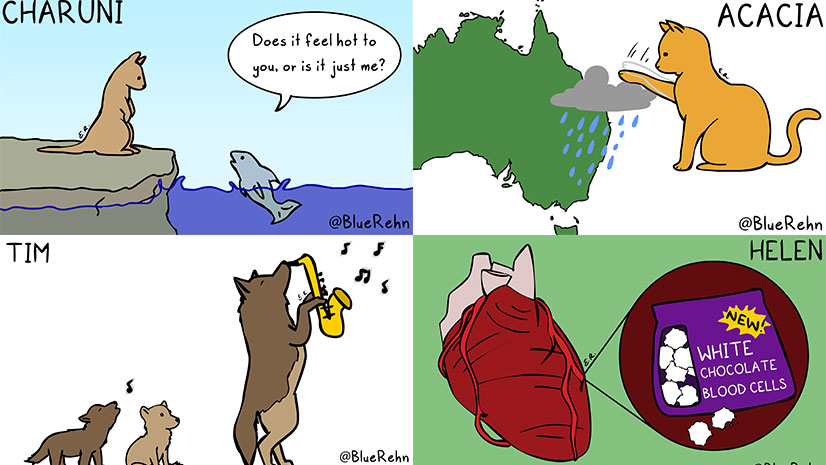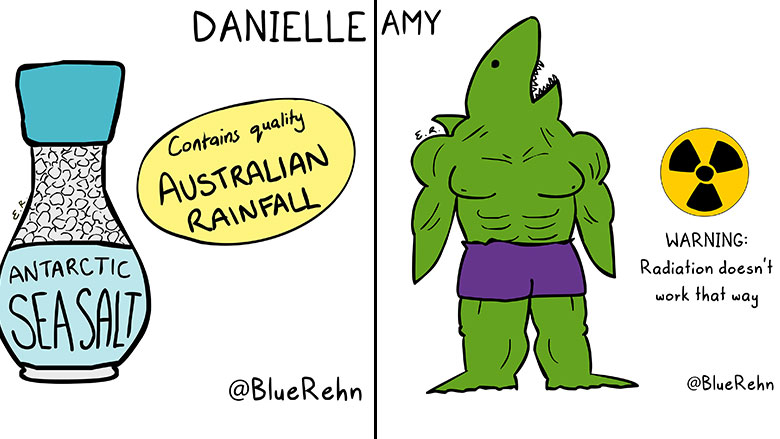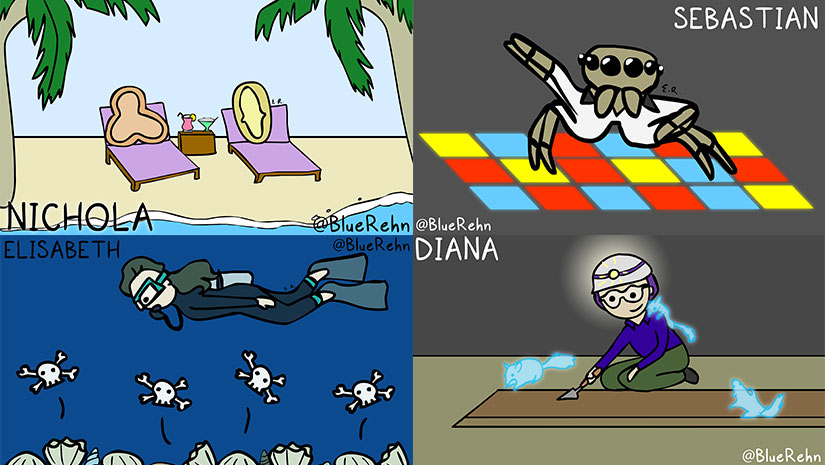
(she/her), Yirrganydji and Yidinji Country
Twitter: @BlueRehn
In October 2021, I posted a tweet that read: “Are you a scientist? Comment with a few words on what you research (plus other things you enjoy, if you want) and I'll draw you a little cartoon”.
Over the whirlwind week that followed, I drew cartoons for 35 scientists. Here are a few tips (not strict rules!) I wanted to share from the process, to help you design a humorous cartoon you could use for public outreach, or even just a fun way to start your next seminar.
No single image can, or should, capture everything about your work. You need to choose a very simple message for your cartoon, so it may have very little scientific content; it’s an icebreaker, not an abstract. It can be tricky to reach this level of simplification for your own work, so talk to a friend or try to pick just two (non-jargon) keywords to summarise your field. Using just a few keywords is how I designed most of these science cartoons (e.g. ‘Tropical Pollen’ for Nichola). This is enough to get people’s attention – you can then use the rest of your talk or social media post to explain the specifics.
Example: ‘Shark Hulk’ for Amy doesn’t show you any of the specifics or results of her research, but it does show that she studies the effects of radiation on marine animals (and that she likes Marvel).

Having a central character (or two) can help make this a cartoon instead of a diagram. This step is easy if you study an animal, and hard if you study a process or concept (but not impossible). For the latter, you might need to create a character experiencing the thing you actually study (e.g. ‘Heat Waves’ for Charuni), or maybe even humorously causing it. Your character will probably need some anthropomorphism, as the cartoon will probably be built around them saying or doing something.
Example: an impossibly large ginger cat is responsible for Australian east coast rainfall in 'Climate Cat’ for Acacia.
Exception: you have an object instead of a character, with the focus instead being on parodying a different type of communication like a postcard or an ad (e.g. ‘Antarctic Sea Salt’ for Danielle).

We all use and recognise symbols all the time. They help us to quickly understand images and to represent non-visual concepts like emotions. Common examples include blue = sadness, yellow = happiness, a skull-and-crossbones = death (or perhaps pirates), and a clock = time. It’s important to be aware of common symbolism, so you can then choose to use it or avoid it. Using symbols effectively can greatly aid simplification but using them incorrectly can leave people confused.
Example: skull-and-crossbones represent deadly toxins from the shellfish seen by a diver in ‘Toxic Shells’ for Elisabeth.

Whether it’s references to popular culture (e.g. ‘Spider Disco’ for Sebastian), blood cells made of chocolate (‘White Chocolate Blood Cells’ for Helen), or a wolf playing the saxophone (‘Mama Wolf Jazz’ for Tim), most of the funniest cartoon ideas aren’t too closely tied to reality. While playing with metaphors works well for humour, it can capture something more about the science being shown as well. All of the examples I’ve described here combine real things in some sort of unreal way.
Example: spectral marsupials keep a close eye on a palaeontologist in Ghost Phascogales for Diana, representing the fossil creatures that she studies.
Hopefully these tips help you to create engaging images to share the great work that you do, whether you choose to draw them yourself or make use of clip art. Be creative and have fun with it!
© 2025 Australian Academy of Science